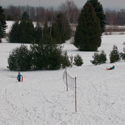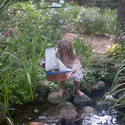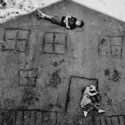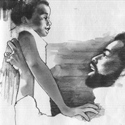I'm sharing this book with you not just because some parts of it are unintentionally funny today (even though they are), but because it remains such a quaint little piece of evidence of how strange the world of children's publishing was in 1969. All of these books show how new psychological and social attitudes filtered down to the media that was being created for kids, where showing them "the truth" (usually through black-and-white documentary photography) was far more important than telling a good story. These books are all earnest and heartfelt and almost universally dull (which I why I have so often made up the captions).
The world this book portrays is as terrifying on the page as it probably was in real life. Junkies attack school kids and push them off rooftops to die after the ambulance doesn't come in time. Feral dogs roam the neighborhood. The streets are filled with bums and drunks. But despite this subject matter, it was clearly intended for a very young audience. Inside my copy I found a stamp from the library of a suburban Detroit elementary school. Who was the book's intended audience? Surely other slum kids didn't need a book like this to show them what was wrong in their neighborhoods. I can only assume the book was intended to show sheltered middle-American kids how terrible life was in the ghetto, perhaps with the intent of spurring them to some sort of activism. Some of the contemporary reactions to the books are telling. Senator Jacob Javits of New York said, "This book will do both---inspire better-positioned boys and girls of all ages to serve and help in the slums and ghettoes---and testify to how unbelievably bad it is but how much can be done!"; Senator Edmund Muskie of Maine said, "If children can get to know each other through this kind of communication, their generation stands an excellent chance of avoiding the fear, mistrust, and lack of understanding that has afflicted our own."
There were similar books published in this era that I also really like (Herb Goro's The Block; Clifford McElroy's house with 100 lights) but what makes this one so strange is its intended audience of very young children. I'm going to ignore a large chunk of the book that shows kids skipping class and drinking and sniffing glue in public parks or tenement rooftops, sharing instead a few pages that focus on some of the neighborhood characters the kids encounter, like good old Buck Teeth Joe Junior:
Or good old Uncle Tio. He really likes to play with kids:
[This post has a lot more pictures from the book, so I'm going to break it up. If you'd like to see the rest of the post, click here]
Any book about life in the slums would be incomplete without a good old-fashioned johnny pump opening:
Success!
The kids also documented some great old-school Williamsburg retail:
If you think those toys are expensive Henry, what till you see what they're charging for a pair of selvedge blue jeans in Williamsburg these days. About half the book is about what kids do up on Williamsburg rooftops, including fighting junkies, raising pigeons, chasing dogs, sniffing glue, and skipping class.
On my absolute favorite page in the book, a young man explains his friends' job at a neighborhood meat market:
And I love this photo of a neighborhood gang. Seriously just look at these guys:
That looks like it could be the press photo for a contemporary Williamsburg hipster band, a group of patrons outside the Metropolitan Bar, or the cast of the 1968 Williamsburg Players' production of West Side Story. They look so pleasant, but I'll bet they could stomp your ass before you got back to Coney better than the Turnbull AC's, the Baseball Furies, and the Gramercy Riffs put together.
See it's so easy to make fun of these old books, but the reality is that I love them. I seek them out and collect them because they speak so directly to the problems they are trying to confront and while none of them will ever be true classics of children's literature, I don't want them lost to obscurity. But you have no idea how hard it was not to make a Bruce Hornsby joke while writing this post.















































